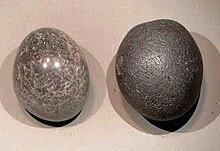Wallstein (attachment)
As Wall stones are ellipsoidal rounded flint pebbles referred to often in Quaternary glacial deposits are also found on the North and Baltic inland. Other popular names for this stone are "crow stones" or "shoemaker stones". Wallstones are always individual, unrolled flint pebbles. In this they differ from the about the same, also unrolled, but konglomeratisch occurring pudding stones .
The smooth, shiny surface of these Cretaceous flint stones, which usually measure around three to six centimeters in the main axis, is littered with numerous small notches. The origin of these stones is controversial. It is assumed that these flints, coming from the Upper Cretaceous ( writing chalk ) or the lowest level of the Tertiary , the Danium , were rolled over a long period of time by the surf on different coasts of a likely ancient Tertiary sea ( Paleocene or Eocene ). Some geologists attribute the strikingly glossy surface of the Wallstones to the fact that the flint blanks were rinsed directly from the writing chalk and the presumably considerable amount of chalk that surrounded them acted as a polishing agent for a long time. The scars on the surface of the stones are interpreted as impact marks due to the effect of the surf. Later, the ellipsoidal stones were washed together to form beach walls . The name “Wallsteine” probably goes back to this. In any case, it is certain that the geologist Ludwig Meyn used this term for the first time. According to another version, Meyn found such stones, which had served as ship ballast, on the Kieler Wall and therefore later gave them this name.
Due to the Quaternary ice advances , which came from the north to Central Europe, the wall stones were transported from their place of origin and are now on the coasts of the North and Baltic Seas and in outcrops, e.g. B. gravel pits, Central European countries. However, egg-shaped, smooth flintstones found on the beach do not necessarily have to be wall stones with the history of origin from the Old Tertiary as described here, since stones were formed by the surf from the sea in later periods up to the present day.
From the Garzweiler opencast mine (Lower Rhine), flint deposits have been described, which are strips of rubble, which mostly consist of egg-shaped, gray-white to bluish shimmering flints. The horizon with these flint bands can be followed to the Dutch province of Limburg . These are also wall stones (regionally also called "Maas eggs"), which did not reach the Lower Rhine Bay in connection with Quaternary ice advances, but in the course of a marine transgression . The flints originally come from now largely eroded chalk deposits in the vicinity (area of Aachen , Hohes Venn , Ardennes ).
literature
- Kurt Hucke : Introduction to bed load research . - 132 p., 50 plates, numerous Text illus., Nederlandse Geologische Vereniging, Oldenzaal, 1967.
- Rolf Reinicke: Flints - Chicken Gods . - 80 p., Numerous Fig., Demmler-Verlag, Schwerin, 2009. ISBN 3910150780 .
- Andrea Rohde: Looking for fossils on the Baltic Sea . - 272 p., Numerous Fig., Wachholtz Verlag , Neumünster, 2008. ISBN 3529054208 .
- Werner Schulz: Geological guide for the north German bed load collector. - 507 p., Numerous Fig., Cw Verlagsgruppe Schwerin, 2003. ISBN 3933781310 .

